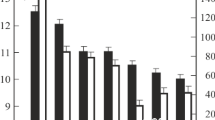Abstract
Both tensile and tear properties of short-fiber reinforced Chloroprene rubber have been studied as functions of the fiber aspect ratio and fiber content. Both properties increased when both the fiber aspect ratio and fiber content were increased. The fiber reinforced rubbers exhibited maximum values of these properties at a fiber aspect ratio of about 300. When the fiber aspect ratio exceeds 400, the mechanical properties decreased with the fiber content because of the non-uniform dispersion of fibers. The tensile modulus was compared with the prediction by the Halpin-Tsai equations for randomly oriented cases. A bonding agent was used in the fiber treating process. It was found that the ultimate tensile strength, torque, tearing energy and tensile modulus of the rubbers with treated fibers were much higher than those with untreated ones.
Similar content being viewed by others
References
Babbit, R. O., 1978,The Vanderbilt Rubber Handbook, R. T. Vanderbilt Com. Inc., pp. 583–590.
Bras, J. L., 1957,Rubber Fundamental of its Science and Technology, Chemical Publishing Co. Inc., pp. 83–128.
Coran, A. Y., Boustany, K. and Hamed, P., 1974, “Short-fiber Rubber Composites,”Rubber Chemistry and Technology, Vol. 47, pp. 394–398.
Derringer, D. C., 1971,Rubber World, Vol. 45, p. 165.
Gedde, Ulf W., 1995,Polymer Physics, Chapman & Hall, pp. 41–45.
Gibson, R. F., 1994,Principles of Composite Material Mechanics, McGraw-Hill Inc., pp. 166–169.
Goettler, L. A., 1988,Handbook of Elastomers, Marcel Dekker Inc., pp. 220–240.
Ismail, H., Rosnah, N. and Rozman, H. D., 1997, “Curing Characteristics and Mechanical Properties of Short Oil Palm Fiber Reinforced Rubber Composites,”Polymer, Vol. 38, No. 16, pp. 4058–4060.
Kar, K. K. and Bhowmick, A. K., 1996, “Hysteresis Loss in Filled Rubber Vulcanizates and Its Relationship with Heat Generation,”J. of Applied Polymer Science, Vol, 64, pp. 1538–1545.
Lee, D. J. and Ryu, S. R. 1999, “The Influence of Fiber Aspect Ratio on the Tensile and Tear Properties of Short-Fiber Reinforced Rubber”, ICCM12, Paris, 1999, Paper No. 26.
Moghe, S. R., 1976, “The Milling Parameters of Short-fiber Reinforced Rubber,”Rubber Chemistry and Technology, Vol. 49, p. 1160.
O’ Conner, J. E., 1977, “Short-fiber Reinforced Elastomer Composites,”Rubber Chemistry and Technology, Vol. 50, pp. 943–946.
Termonia, Y., 1994, “Structure-Property Relationships in Short-fiber Reinforced Composites,”J. of Polymer Science; Part B, Vol. 32, pp. 969–978.
Termonia, Y., 1990, “Tensile Strength of Discontinuous Fiber Reinforced Composites,”J. of Material Science, Vol. 25, pp. 4644–4653.
Wolff, S. and Wang, M. J., 1993,Carbon Black Science and Technology, Marcel Dekker Inc., New York, pp. 315–329.
Author information
Authors and Affiliations
Corresponding author
Rights and permissions
About this article
Cite this article
Ryu, SR., Lee, DJ. Effects of fiber aspect ratio, fiber content, and bonding agent on tensile and tear properties of short-fiber reinforced rubber. KSME International Journal 15, 35–43 (2001). https://doi.org/10.1007/BF03184796
Received:
Revised:
Issue Date:
DOI: https://doi.org/10.1007/BF03184796




